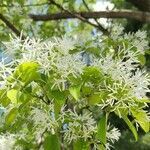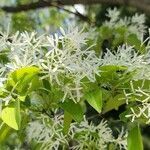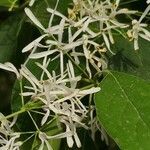Shrubs or trees to 20 m. Branchlets terete, spreading, glabrous, or pubescent when young. Petiole 0.5-2 cm, densely covered with curly hairs; leaf blade oblong, elliptic, or orbicular, sometimes ovate or obovate, 3-12 × 2-6.5 cm, usually somewhat leathery, adaxially villous along veins, abaxially villous or glabrescent except on veins, base rounded to cuneate, rarely subcordate, apex blunt, sometimes retuse or acute; primary veins 3 or 4 on each side of midrib, slightly raised. Cymose panicles terminal on lateral shoots, 3-12 cm, glabrescent. Pedicel slender, 0.5-2 cm, glabrous. Calyx 1-3 mm; lobes narrowly deltate or lanceolate, 0.5-2.5 mm. Corolla white; tube 1.5-4 mm; lobes linear-oblanceolate, (1-) 1.5-2.5 cm. Anthers long ovate, 1.5-2 mm. Drupe blue-black or black, pruinose, ovoid, 1-1.5 cm × 6-10 mm. Fl. Mar-Jun, fr. Jun-Nov. 2n = 46*.
More
A deciduous tree. It grows 3-10 m high. The tree is broadly spreading. The bark is grey-brown and corky. It is deeply furrowed. The leaves are oval and 10 cm long by 5 cm wide. They have either a blunt point are an indent. There can be fine teeth. They are glossy green above and paler underneath. The male and female flowers are on separate plants. The flowers are creamy white with narrow petals. They are about 2 cm long. They are in upright panicles at the end of the shoots. The fruit is an egg shaped berry. It is 1.5 cm long and deep blue.
It is a temperate plant. It is native to China and Japan. It grows in woods and on cliffs in sunny, moist places. It will grow in alkaline soils. It suits hardiness zones 6-10. Arboretum Tasmania. In Sichuan and Yunnan.



